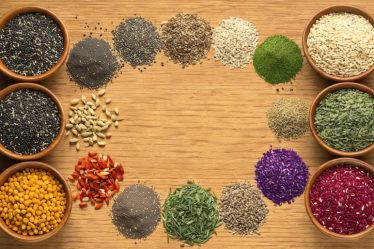
Discover the untapped potential of organic whole grain wheat – nature’s powerhouse of nutrition and sustained energy. Unlike its processed counterparts, organic whole grain wheat retains all three vital parts of the wheat kernel: the fiber-rich bran, the nutrient-packed germ, and the energy-providing endosperm. This complete package delivers essential nutrients, including B vitamins, fiber, protein, and minerals that work together to fuel your body throughout the day.
As someone who made the switch to organic whole grain wheat five years ago, I’ve experienced firsthand how this ancient grain can transform daily energy levels and overall wellness. Modern farming methods ensure we get the purest form of this remarkable food, free from synthetic pesticides and genetic modification, while preserving its natural nutritional profile.
Whether you’re a busy professional seeking sustained energy or a health-conscious parent looking for wholesome family meals, organic whole grain wheat offers a versatile foundation for better nutrition and lasting vitality.
The Real Difference Between Regular and Organic Whole Grain Wheat
What Makes It ‘Organic’?
When I first started exploring organic foods, I was amazed to learn what goes into earning that “organic” certification on wheat products. For wheat to be labeled organic, farmers must follow strict guidelines set by the USDA. These include using natural fertilizers instead of synthetic ones, rotating crops to maintain soil health, and avoiding genetically modified seeds.
The certification process requires farmers to keep their fields free from prohibited substances for at least three years before harvest. They also need to implement natural pest control methods, like beneficial insects and companion planting, rather than using chemical pesticides. What I love most about organic farming is how it focuses on building healthy soil – the foundation for growing nutritious wheat.
Think of organic farming as working with nature rather than against it. Farmers use methods like cover cropping and composting to enrich the soil naturally. This not only produces healthier wheat but also helps protect our environment by promoting biodiversity and reducing chemical runoff into our water systems. It’s a win-win for both our bodies and the planet!

The Whole Grain Advantage
Ever wondered why whole grain wheat feels so much more satisfying than its refined counterpart? Let me share a little secret: it’s all about keeping things whole and natural! When wheat is processed, it loses two of its most valuable parts – the bran and germ – leaving only the starchy endosperm. But whole grain wheat keeps all three parts intact, making it one of nature’s true nutritional powerhouses.
Think of it like this: while refined wheat is like getting just the sugar from an apple, whole grain wheat is like eating the entire fruit – complete with all its goodness! You’re getting fiber from the bran, which helps keep you feeling full and supports healthy digestion. The germ provides essential vitamins and minerals, including vitamin E and B vitamins, while those healthy fats give you sustained energy throughout the day.
What really makes my heart sing about whole grain wheat is how it helps stabilize blood sugar levels. Unlike refined wheat, which can cause those dreaded energy crashes, whole grain wheat provides steady, lasting energy – perfect for powering through busy days or keeping up with the kids!
Energy-Boosting Benefits You’ll Actually Notice
Complex Carbs for Lasting Energy
Ever wondered why some mornings you’re riding high on energy, while others leave you crashing before lunch? The secret might just lie in your choice of carbohydrates. As someone who used to struggle with mid-morning energy slumps, I discovered that switching to organic whole grain wheat made a remarkable difference in my daily energy levels.
Unlike refined grains that give you a quick energy spike followed by an inevitable crash, organic whole grain wheat is nature’s answer to sustained energy release. Think of it as your body’s time-release capsule – the complex carbohydrates break down slowly, providing a steady stream of energy that keeps you going throughout the day.
What makes whole grain wheat so special? It’s all in the structure. The bran, germ, and endosperm work together to slow down digestion, which means glucose (your body’s primary energy source) is released gradually into your bloodstream. This natural process helps maintain stable blood sugar levels, keeping those dreaded energy crashes at bay.
The fiber content in whole grain wheat also plays a crucial role. It not only slows down digestion but also helps you feel fuller for longer. This means you’re less likely to reach for those quick-fix sugary snacks that can disrupt your energy levels.
From my experience, incorporating organic whole grain wheat into breakfast – whether in bread, cereals, or porridge – has been a game-changer for maintaining consistent energy levels until lunchtime.

The Fiber-Energy Connection
Ever wonder why you feel energized after enjoying a slice of hearty whole grain bread, while processed white bread leaves you crashing an hour later? The secret lies in the amazing fiber content of organic whole grain wheat. As someone who used to struggle with afternoon energy slumps, discovering this connection was a game-changer for my daily routine.
The fiber in organic whole grain wheat works like your body’s natural energy management system. When you consume whole grain wheat, its fiber creates a slow, steady release of carbohydrates into your bloodstream, helping you maintain consistent energy levels throughout the day. Think of it as the difference between a steady stream versus a sudden flood – your body appreciates the gradual approach!
What makes this particularly special is the combination of soluble and insoluble fiber found in whole grain wheat. The soluble fiber forms a gel-like substance during digestion, which slows down the absorption of sugars. Meanwhile, the insoluble fiber helps maintain healthy digestion, ensuring your body efficiently processes the nutrients it needs for sustained energy.
Many of my readers have shared how switching to organic whole grain wheat has helped them say goodbye to those mid-afternoon energy crashes. The fiber-energy connection isn’t just about avoiding sugar spikes – it’s about giving your body the steady fuel it needs to power through your busy day with consistent energy levels.
Easy Ways to Add It to Your Daily Routine

Breakfast Energy Boosters
Starting your day with organic whole grain wheat can transform your morning routine and energy levels. As someone who used to struggle with mid-morning crashes, I’ve discovered that incorporating these wholesome grains into my healthy breakfast options has made a world of difference.
Here are three quick and delicious ways to power up your mornings:
1. Overnight Wheat Berry Parfait
Mix cooked wheat berries with Greek yogurt, honey, and your favorite fruits before bed. By morning, you’ll have a creamy, protein-rich breakfast that keeps you energized until lunch.
2. Whole Wheat Power Toast
Toast organic whole grain bread and top it with mashed avocado, a poached egg, and a sprinkle of hemp seeds. This combination provides sustained energy through complex carbohydrates and healthy fats.
3. Quick Wheat Berry Breakfast Bowl
Batch-cook wheat berries on Sunday and store them in the fridge. Each morning, warm a portion with almond milk, cinnamon, and maple syrup. Add fresh berries and chopped nuts for extra nutrition and crunch.
Pro tip: To save time on busy mornings, prepare your wheat berries in bulk during weekend meal prep. They’ll stay fresh in the refrigerator for up to five days, making it easier to create nutritious breakfasts throughout the week.
Remember, the key to maximizing energy benefits is combining organic whole grain wheat with protein and healthy fats. This trio helps maintain stable blood sugar levels and provides lasting energy for your busy morning ahead.
Snack Smart with Whole Grains
When it comes to smart snacking, organic whole grain wheat offers endless possibilities that are both delicious and nutritious. As someone who used to struggle with mid-afternoon energy crashes, I’ve discovered that incorporating these wholesome grains into my snacks has made a world of difference in maintaining steady energy levels throughout the day.
Let’s explore some creative ways to satisfy those snack cravings while practicing mindful eating habits. Try making your own whole grain wheat crackers by mixing organic wheat flour with herbs and seeds – they’re perfect for dipping in hummus or topped with avocado. For a sweet treat, whole grain wheat berries can be popped like popcorn and drizzled with a touch of honey.
One of my favorite grab-and-go options is homemade whole grain wheat granola bars. Simply combine rolled wheat flakes with nuts, dried fruits, and a natural sweetener like maple syrup. These portable powerhouses keep me fueled during busy days and are a hit with my kids too!
Don’t forget about the classic whole grain wheat toast – but let’s elevate it! Top it with almond butter and banana slices for a protein-rich snack, or try cottage cheese and fresh berries for a calcium boost. For something savory, mashed chickpeas with olive oil and Mediterranean herbs create a satisfying afternoon pick-me-up.
Remember, the key to successful snacking is preparation. Keep pre-portioned whole grain wheat snacks in your bag or desk drawer, so you always have a healthy option within reach when hunger strikes.
Making the switch to organic whole grain wheat is one of the best decisions you can make for your health and well-being. As we’ve explored throughout this article, this powerhouse grain offers an impressive array of benefits – from sustained energy levels and improved digestion to better heart health and weight management. Plus, choosing organic ensures you’re getting these benefits without unwanted pesticides or artificial additives.
I remember when I first started incorporating organic whole grain wheat into my daily meals. Like many of you, I was a bit hesitant about the taste and texture. But now, I couldn’t imagine my kitchen without it! The nutty flavor and satisfying chew have become something I genuinely look forward to.
Whether you’re baking fresh bread, enjoying a hearty breakfast bowl, or experimenting with wheat berries in salads, there are countless delicious ways to make organic whole grain wheat part of your daily routine. Start small by making simple swaps in your favorite recipes, and soon you’ll discover just how versatile and satisfying this ancient grain can be.
Ready to embrace a healthier lifestyle? Take the first step today by adding organic whole grain wheat to your shopping list. Your body (and taste buds) will thank you!



